Yoga for Cancer patients and survivors is known to immensely improve strength, hope & vitality, though not a cure.
The most feared of all diseases, Cancer is the abnormal proliferation of cells with the ability to invade and spread to other body parts. They grow in the form of tumors and becomes life-threatening when the body’s life support functions are compromised due to cellular damage.
A malignant tumor is one with the tendency to grow and invade surrounding tissues while a benign tumor – while still cancerous, is much less threatening as they are much less likely to spread. Most often they can be removed surgically too.
Everybody produces cancerous cells. A healthy body with a strong immune system can destroy these cells. In patients who develop cancer, the body’s ability to effectively deal with these cancerous cells has been compromised. This is due to excessive use of tobacco, obesity, poor diet, excessive drinking of alcohol, and exposure to ionizing radiation and environmental pollutants.
About 15% of cancer is caused because of infections such as Helicobacter pylori, Hepatitis B, Hepatitis C, Human Papillomavirus infection, HIV etc and some of the causes may be genetics. Stress is another huge factor that causes imbalances in the mind. Accumulation of stress can lead to imbalances in the body and result in the manifestation of the disease at the body’s weakest point.
While the causes may be many, both diagnosis and treatment of cancer create a physical as well as a psychological threat to the patient. The line of treatment is usually multi-modal and stretched over a long period of time. During this course, a patient suffering from cancer undergoes a lot of changes and accumulates a lot of morbidities.
The treatment for cancer is associated with a lot of side effects such as changes in appearance, hair loss, fatigue, nausea, vomiting, tastelessness, pain, low immunity, low blood count, infertility and even altered sexual functioning. It affects the patient’s quality of life and also the patient may go into depression due to prolonged treatment and enormous side effects.
Yoga for Cancer
When battling cancer, patients struggle not just the symptoms of the disease itself, but often the discomfort and fatigue brought on from the various treatments they have to endure. Whether it is surgery, ongoing nausea or even weakness from chemotherapy or radiation, cancer patients have to endure a long road of physical trials.
Yoga’s holistic approach is known to help cancer patients during and after their treatment. As such Yoga may not cure cancer as a whole, however, Yoga asanas and Pranayama designed for cancer patients are easy and relaxing as it encourages buoyancy.
Yoga therapy can help clear out the toxins accumulated during treatment. The asanas stimulate not just muscles, but also increases blood flow, balances the glands and enhances the lymphatic flow in the body, all of which enhances the body’s internal purification processes. The deep, relaxing breathing in Yoga increases oxygen-rich blood to the cells, supplying nutrients and clearing out toxins.
Cancer patients also undergo a lot of physical and emotional anguish. Practicing Yoga helps patients keep their mind calm and allows them to cope better with their treatment.
Yoga practice can give relief tension and anxiety and stress, which can depress the body’s natural immune functions. This gives them a sense of ease and well-being. It is also known to help to reduce symptoms and side effects such as pain, tiredness, reduce sleep disturbances, day-time drowsiness, and depression. It helps build endurance, emotionally and physically.
Yoga also helps bring back the lost harmony and balance within the body, mind, and soul; thus restoring its health. It helps lift the mood and enhance well-being.
Yoga is also known to give energy and strength needed by patients after surgery. With better-controlled breathing, meditation and asanas, Yoga helps address the physical challenges resulting from the disease and its treatment, especially lymph distribution and the immune system, and gives much physical, mental, spiritual relief.
Let us learn how Yoga can help with Cancer:
The human body has 5 existential states –
- Annamaya Kosha (gross physical body with organs and systems),
- Pranamaya Kosha (subtle functional body),
- Manomaya Kosha (mind with emotions and thoughts),
- Vignanamaya Kosha (intellectual and reasoning) and
- Anandamaya Kosha (state of bliss).
The psychosomatic phenomenon of a disease can be explained as an imbalance or ignorance in the Manomaya kosha that leads to confusion and stress which intern infiltrates as a physiological change in Pranamaya kosha and it finally percolates and results in changes in the Annamaya kosha.
When there is an imbalance in the other levels of kosha, the Vignanamaya kosha gets disturbed. In Cancer patients, there is an imbalance in the physical level when irrational cell division takes place in the body.
Yoga practice helps all five levels of kosha and this, in turn, helps in the correction of imbalance in each kosha and aids in the restoration of homeostasis. Asanas and kriyas act at the level of Annamaya kosha, Pranayama at the level of Pranamaya kosha, Meditation at the level of Manomaya Kosha and Yoga Nidra and counseling works at the level of Vignanamaya kosha. With continuous practice, internal awareness increases, and this leads to balance and restoration of energy.
Here are a few asanas that will help in healing the body and the mind.
Cat-Cow Pose:

- Sit in Vajrasana and then leave 1 forearm gap between your knees and in front of the knees.
- Stand on the knees and hands.
- Exhale curve your spine outwards and look in.
- Inhale curve your back inwards and look up.
- Repeat the movements for 11 times.
Hands In and Out Breathing:
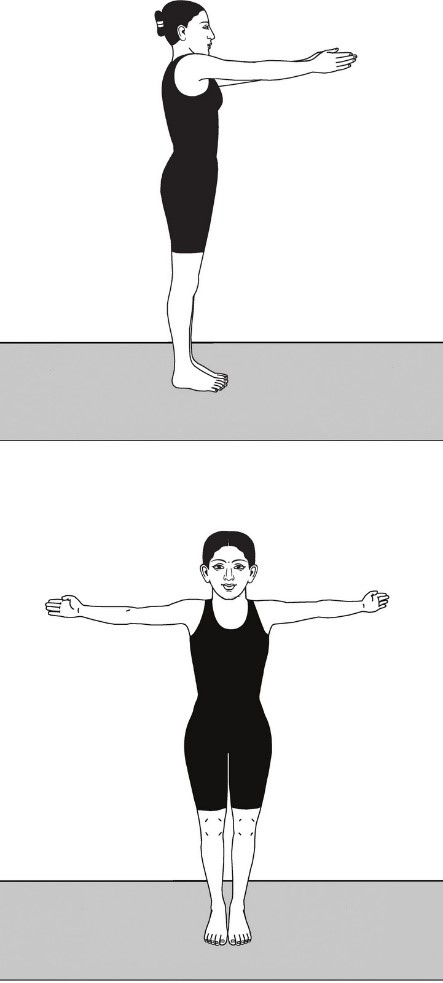
- Stand in Tadasana
- Stretch the arms in front. Keep it in level with your shoulders and bring the palms together.
- Breathing in and spread your arms sideways in the horizontal plane.
- While breathing out again bring the arms forward with palms touching each other.
- Repeat the same for 11 times while synchronizing breathing with movements of your arm
Trikonasana (Triangle Pose):
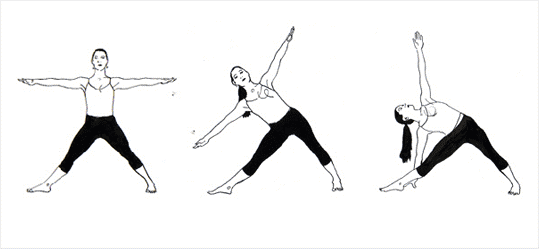
- Start with Tadasana
- As you inhale spread the feet 3 feet apart and raise both the hands slowly till they reach horizontal position simultaneously.
- Now slowly bend sideways to the right side until the right-hand reaches the right foot. Left-arm stays up and in line with the right hand. Palms face forward. Stretch the left arm.
- Maintain for about a minute with normal breathing.
- Return to Tadasana slowly.
- Repeat on the left side
Ardha Matsyendrasana (Seated Spinal Twist):
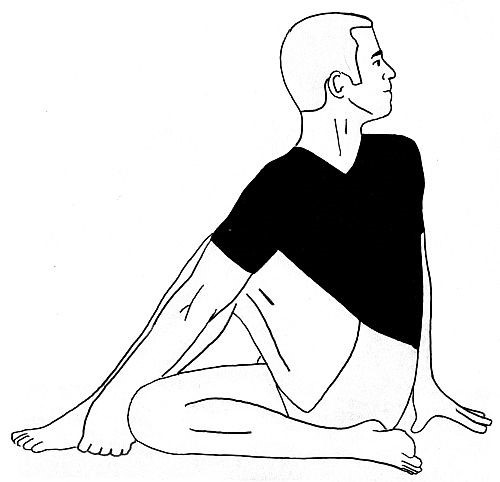
- Start from Dandasana
- Bend the right leg at the knee, along the ground.
- Keep the right heel about 4 to 5 inches away from the perineum.
- Bend the left knee and place the left foot on the outer side of the right thigh near the right knee.
- Do not sit on the heels.
Viparitakarni (legs up on the wall):
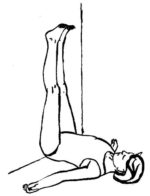
- Sit on the floor with your left side against the wall.
- Turn to the left and bring your legs up against the wall as you lower your body into a prone position.
- Adjust your buttocks against the wall.
- Your shoulders and head will rest on the floor while your legs stretch up the wall in this relaxed position.
Nadi Suddhi Pranayama:
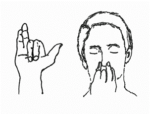
- Sit in any meditative posture with your back erect and adopt Nasika mudra.
- Close the right nostril with the right thumb and exhale completely through the (left) nostril. Then inhale through the left nostril.
- Close the left nostril with your ring and little fingers of the Nasika mudra release the right nostril. Now exhale slowly and completely through the right nostril.
- Inhale deeply through the right nostril. Close the right nostril and exhale through the left nostril. This would complete one full round of Nadi suddhi Pranayama.
- Repeat for 9 rounds.
Yoga Nidra:

- Allowing your body 10 to 20 minutes of relaxation in Shavasana is a great way to rejuvenate your energy. Relaxing the whole body with consciousness helps to heal the pain more easily.
- It is also recommended to chat Om as the vibrations created by the chanting Om can strengthen and stabilize the body.
- There are many forms of Yoga Nidra like deep relaxation technique, mind sound resonance technique and quick relaxation technique that is known to help to a great extent.
What to watch out for?
Yoga is generally very safe if done properly and under instructions from a qualified teacher. Some important things to remember:
- Do not practise Yoga for at least 2 hours after eating;
- Inform your trainer about any medical problems, including back and joint problems;
- Stop and inform your trainer if a posture is uncomfortable or painful ;
- Keep the body well hydrated after every class.
